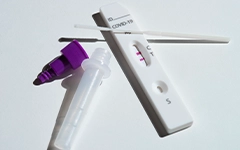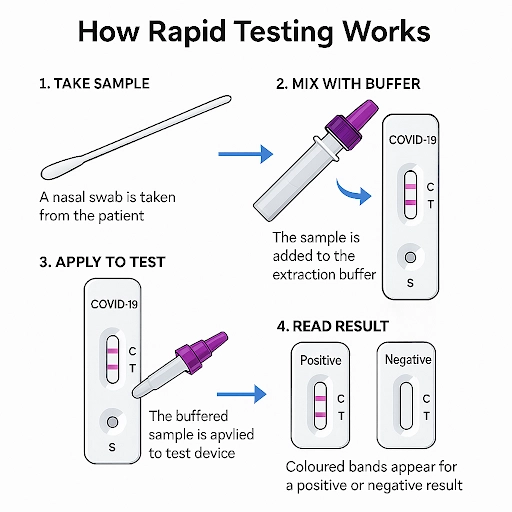List of All Services Offered By Prime Medic
List of All Services Offered By Prime Medic
List of All Services Offered By Prime Medic

How Does Rapid Testing Work

COVID-19 Rapid Antigen Test Kits are intended as screening tools for self-use during the early stage of infection by detecting proteins (antigens) from the SARS-CoV-2 virus, the coronavirus that is responsible for COVID-19. These tests are generally used as a preliminary testing tool and can be conducted either at home or in supervised settings.
What's Inside the Kit?
Most approved rapid test kits include:
- A test device (like a cassette)
- A sterile swab for sample collection
- A tube with buffer solution
- A nozzle cap or dropper
Each component plays a role in detecting the presence of viral antigens, which are proteins associated with SARS-CoV-2.
Step-by-Step: What Happens During the Test
- Sample Collection: A swab is used to collect a sample from the nose or throat, depending on the test's instructions.
- Mixing the Sample: The swab is then inserted into the buffer tube to mix and release any virus antigens that may be present.
- Application to Test Device: A few drops of the mixed sample are added to the testing area (marked as "S" on the strip).
- Result Interpretation: As the liquid moves along the test strip, it interacts with antibodies embedded on the device. If viral antigens are present, they bind to the antibodies and form a coloured line in the test area (T). A second line appears in the control region (C) to confirm the test is working properly.
- If viral antigens are present, they bind to the antibodies and form a coloured line in the test area (T).
- In the control region (C), a second line is observed to verify that the test is working correctly.

Important to Know
- Positive test result means SARS-CoV-2 antigens are present. People who receive a positive result must follow public health directions about isolation and additionally, testing.
- A negative result, however, does not rule out that the person does not have a Covid-19 infection. If the symptoms persist or there is contact with the infected person, individuals with symptoms or known exposure are encouraged to consult a healthcare professional for further guidance.
Limitations of Rapid Tests
Rapid antigen tests are generally more reliable when used in the early stages of infection and when symptoms are present. However:
- False negatives can be more frequently seen in non-symptomatic cases.
- The decision should be supported by clinical symptoms and official advice.
- Remember to read thoroughly the provided instructions before conducting the test.
Stay Safe, Stay Informed
In any case, even if the result is negative, adhering to COVID-safe behaviours, including social distancing, wearing a mask, practicing good hand hygiene, and staying at home as per the instructions of a healthcare professional, is still very necessary.